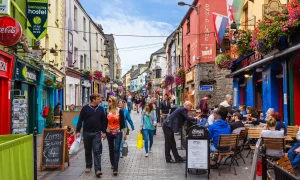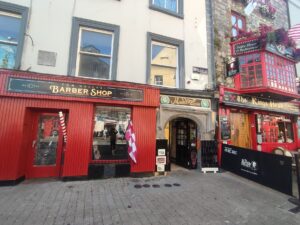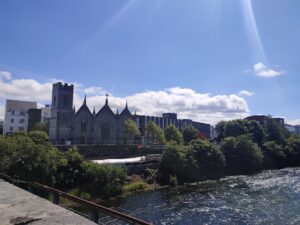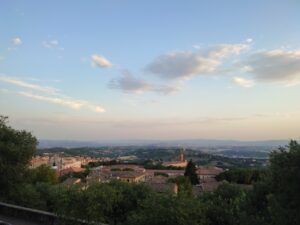With centuries of history, Galway is such a sweet city, right out of a fairy tale…but the kind with dragons and a happy ending. It is so charming that once one sets foot in it, they get enchanted.

The area around Galway has evidence of human settlement dating back to the Mesolithic era. The first known settlers were the Celts, who arrived in Ireland around 500 BC.
In the 12th century, the Normans invaded Ireland and established a presence in the region. They constructed a fortification known as the Castle of the Tribes, which later became Galway Castle.
Galway began to develop as a town in the 13th century. Richard de Burgo, a Norman lord, founded the Anglo-Norman settlement of Galway in 1232. The town grew rapidly and became an important trading hub.
Galway was ruled by a group of fourteen merchant families known as the Tribes of Galway. These families played a significant role in the city’s economic and political life from the 13th to the 19th century (Tribal Confederation).
Galway thrived as a trading port during the medieval period. It had extensive trade links with other European cities and was a center for the export of local products like wool. The town also became a cultural and educational center, with the establishment of the Collegiate Church of St. Nicholas in the 14th century.
The town faced significant challenges during the 17th century due to the Cromwellian and Williamite wars. The town was besieged and captured by English forces in 1652 and experienced a decline in its economic and political importance.
To protect the city from attacks, extensive defensive walls were constructed around Galway in the 13th and 14th centuries. These walls featured several towers and four main gates: the Spanish Arch, the North Gate, the East Gate, and the West Gate. The Spanish Arch, the only remaining section of the city walls, is a popular tourist attraction today.
Political Struggles: Galway faced political challenges during its history. The city initially supported the Catholic cause during the English Civil War in the mid-17th century. However, it eventually fell to Cromwellian forces in 1652. The Protestant ascendancy gained power, leading to the decline of Galway’s Catholic population and its economic and political importance.
The mid-19th century brought hardship to Galway with the arrival of the Great Famine (1845-1852). The region suffered from widespread potato crop failures, leading to mass starvation and emigration. Galway, like many other parts of Ireland, experienced a decline in population during this period.

The town saw a revival in the 19th century, with the development of industries such as fishing, shipbuilding, and the Claddagh lace industry. However, it also faced challenges during the Great Famine in the 1840s, resulting in a decline in population.
In the 20th century, Galway experienced significant growth and development. It became an important center for education, with the establishment of the National University of Ireland, Galway (NUIG) in 1845. The city also became known for its vibrant arts scene and festivals, including the Galway Arts Festival and the Galway International Oyster Festival.
Today, Galway is a thriving city known for its vibrant culture, picturesque landscapes, and historical charm. It attracts visitors from around the world and continues to be a major center for arts, education, and tourism in Ireland.

Galway offers a variety of attractions and holds significant importance today. Here are some of the main attractions and why they are noteworthy:
Eyre Square (John F. Kennedy Memorial Park): Located in the heart of Galway, Eyre Square is a popular gathering spot and a symbol of the city. It features a statue of President John F. Kennedy, commemorating his visit to Galway in 1963. The square is surrounded by shops, restaurants, and is a vibrant meeting place for locals and visitors.
Galway Cathedral: The Cathedral of Our Lady Assumed into Heaven and St. Nicholas, commonly known as Galway Cathedral, is one of the city’s most iconic landmarks. It was constructed in the mid-20th century and features stunning architecture, intricate stained-glass windows, and beautiful artwork.
Spanish Arch: The Spanish Arch is a historic stone archway that once formed part of the city’s defensive walls. It was originally built in the 16th century and served as a point of entry for ships arriving from Spain. Today, it is a popular spot for locals and tourists to enjoy scenic views of the river Corrib.

Galway City Museum: Located near the Spanish Arch, the Galway City Museum offers fascinating exhibits on the history and heritage of Galway. It covers various aspects, including archaeology, art, and the city’s maritime history. The museum provides insight into Galway’s past and cultural significance.
Shop Street: Shop Street is Galway’s main thoroughfare, lined with charming shops, restaurants, and traditional pubs. It is a bustling pedestrian street known for its lively atmosphere, street performers, and a wide range of shopping opportunities. Shop Street is a hub of activity and a must-visit for anyone exploring Galway.
Galway Arts Festival: The Galway Arts Festival is one of Ireland’s most prominent arts events, drawing artists and performers from around the world. It takes place annually, featuring a diverse range of performances, exhibitions, street art, and cultural events. The festival showcases Galway’s vibrant arts scene and contributes to its reputation as a cultural hub.
Galway Bay and the Aran Islands: Galway’s proximity to the stunning Galway Bay and the nearby Aran Islands adds to its allure. The bay offers beautiful coastal scenery, sandy beaches, and opportunities for water activities. The Aran Islands, located off the coast, are known for their unique cultural heritage, traditional Irish language (Gaelic), and ancient archaeological sites.
National University of Ireland, Galway (NUIG): NUIG is one of Ireland’s leading universities, renowned for its academic excellence and research contributions. It attracts students from around the world and plays a significant role in Galway’s educational and cultural landscape.
These attractions, among others, contribute to Galway’s importance as a vibrant cultural, educational, and tourist destination. The city’s mix of historical charm, natural beauty, festivals, and artistic endeavors make it a captivating place to visit and experience.
If you ever visit Ireland for any reason (trust me there are sooo many reasons why someone can be in the country), do not miss the chance to set foot in Galway-my personal favourite, my candy town.





